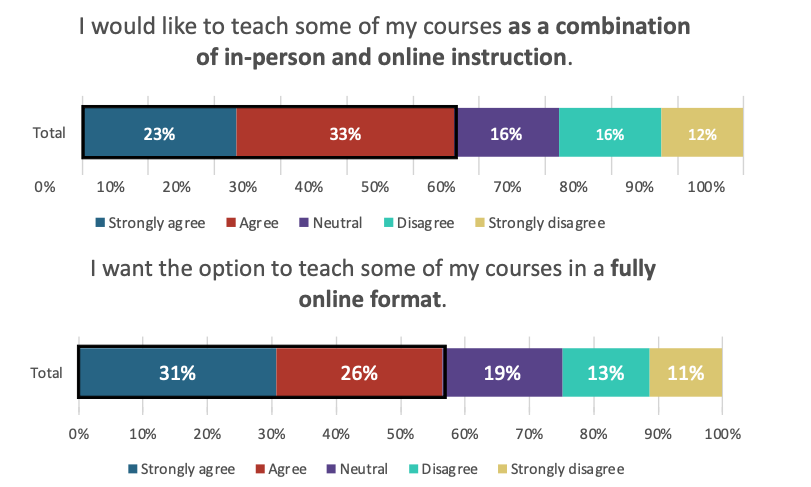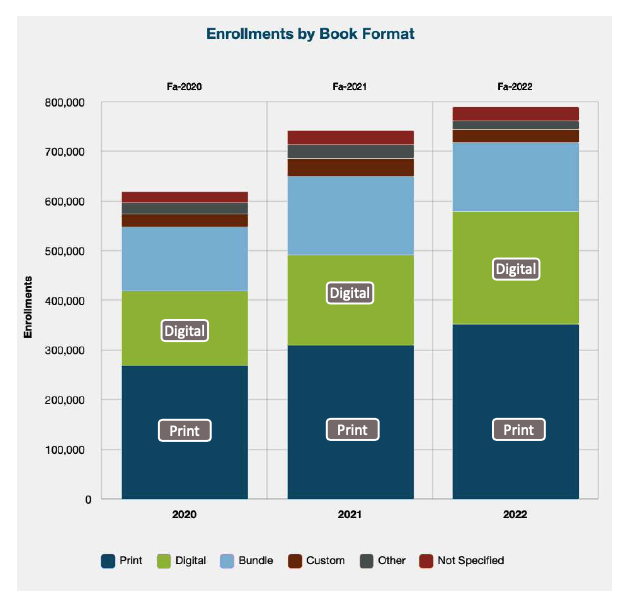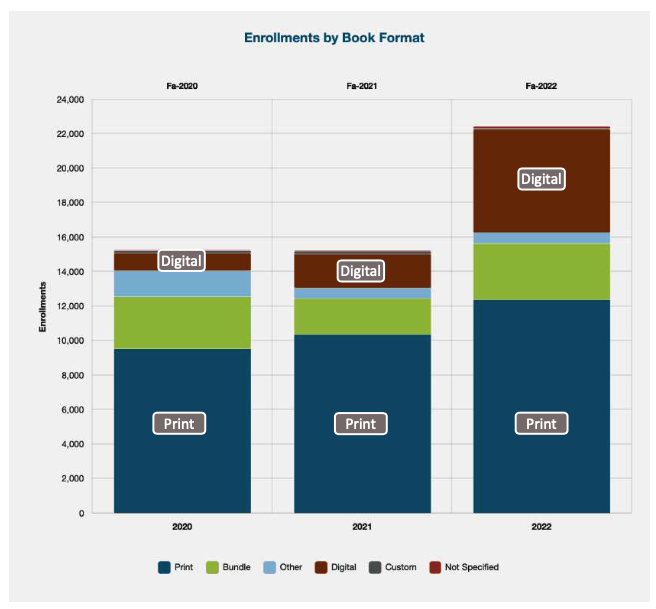Research Article:
Digital and OER Textbook Adoption
Over the last decade, the required textbook — the most common educational material in use in higher education courses in the U.S. — has undergone a transformation. Shifting trends in technology, rising costs, and growing distaste with the publishing industry have coincided with a growing preference for digital courseware, materials, and tools.At Bay View Analytics, we've been tracking the curricula discovery, selection, and adoption process in higher education since 2009 through a series of surveys and reports aimed at faculty and administrators across the U.S. We recently partnered with the Brian Murphy Group, the most comprehensive source of market intelligence focused on U.S. higher education curriculum and course materials. They shared their course-level data and analytics for selected large-enrollment introductory-level courses for the Fall 2020, Fall 2021, and Fall 2022 terms.
A Time of Transition
The global COVID-19 pandemic exacerbated the shift from print to digital, as higher education institutions in the U.S. scrambled to implement digital tools to keep their newly-remote classrooms afloat. A direct result of this forced transition to online learning was a surge in faculty and administrator exposure to online learning.In a survey conducted by Bay View Analytics during the 2021-2022 academic year, the majority of faculty and administrators said the COVID-19 pandemic improved their opinions of online learning (54% and 59%, respectively), and their acceptance of digital materials (68% and 79%). Additionally, over 90% of faculty state that the pandemic was the catalyst of some change to their teaching techniques, favoring the use of digital textbooks, online learning managements systems, and the like. After a return to "normalcy," with students returning to the classrooms, the majority of teachers still want to teach online — if not exclusively, then as an option.

The shifts in perspectives on digital learning is part a growing acceptance of digital materials that we've been monitoring for years. During the 2018-2019 academic year, 44% of faculty agreed with the statement "Students learn better form print materials than they do from digital." By the 2021 - 2022 academic year, that figure dropped to 33%. In the same academic year, the majority of faculty and administrators expressed agreement with the statement "Digital materials provide greater flexibility for students." Only a small number disagree with the statement (5% faculty, 4% administrators), with only 1% of faculty strongly disagreeing.
Digital Adoption Trends are Course Specific
Our findings have helped us establish and track the growing preference for digital textbooks. With assistance from the high quality dataset provided by the Brian Murphy Group, we're able to learn more from the sentiments our data have illustrated. To start, the Brian Murphy Group dataset offers an overview of the higher education landscape, at a granular level. For Bay View Analytics' purposes, that means getting a detailed view of the growth of the digital textbook landscape.
Here's one example. In this graph, we can see student enrollment trends in Intro Psychology courses during the Fall 2020, 2021, and 2022 academic years, based on the format of textbooks purchased. The proportion of digital only and print textbooks increased with the number of enrolled students. The growth of digital only books is growing faster than print, though still numbers behind print for the moment.

Here's another example. This graphs shows the student enrollment trends in Intro Physics courses during the same time period. In 2022, the proportion of digital textbooks purchased accounted for almost all of the new growth, readily eclipsing the growth of print.
Conclusion
In both examples, print textbooks remain a dominant form factor. But the growing demand for digital textbooks speaks to where demand may be heading. We can use this information to help institutions and administrators plan for the future. Previous Bay View Analytics reports have shown that faculty, administrator, and student preferences for digital or textbooks varies by discipline.With the Brian Murphy Group's dataset we can focus in on particular disciplines, drilling down to individual texts if necessary, and make direct, informed recommendations to key decision makers. Example questions that can be addressed are:
- What are the popular textbooks used for specific courses?
- Which departments need more support for digital adoption?
- What are the student enrollment trends between disciplines?
Bay View Analytics, with support from the Hewlett Foundation, conducts annual, national surveys of faculty and administrators on topics related to curricula adoption, and tracking awareness levels of Open Educational Resources (OER) — learn more here.
Recent Publications
Open Educational Resources
- Approaching a New Normal? Educational Resources in U.S. Higher Education, 2024
- Conflicted Digital Adoption: Educational Resources in U.S. K-12 Education, 2024
- Research Brief: Digital and OER Textbook Adoption
- Research Brief: Faculty Satisfaction with Course Materials varies by Publisher
Course Material Affordability
Digital Learning Pulse Surveys
- Infographic: 2023-2024 Digital Learning Pulse Survey
- The Digital Transformation of the Community College
- Planning for a Smaller Future: Dealing with Declining Enrollments
STEM
- Teaching Online: STEM Education in the Time of COVID
- What Makes a STEM Student
- Perceptions of the Future of STEM Education
Distance Education
- Digital Faculty: Faculty Social Media Use and Communications
- Infographic: Digital Faculty
- Grade Increase: Tracking Distance Education in the United States
Follow us on
Privacy
All survey respondents are provided complete anonymity. No personally identifiable information is released. Full privacy policy.